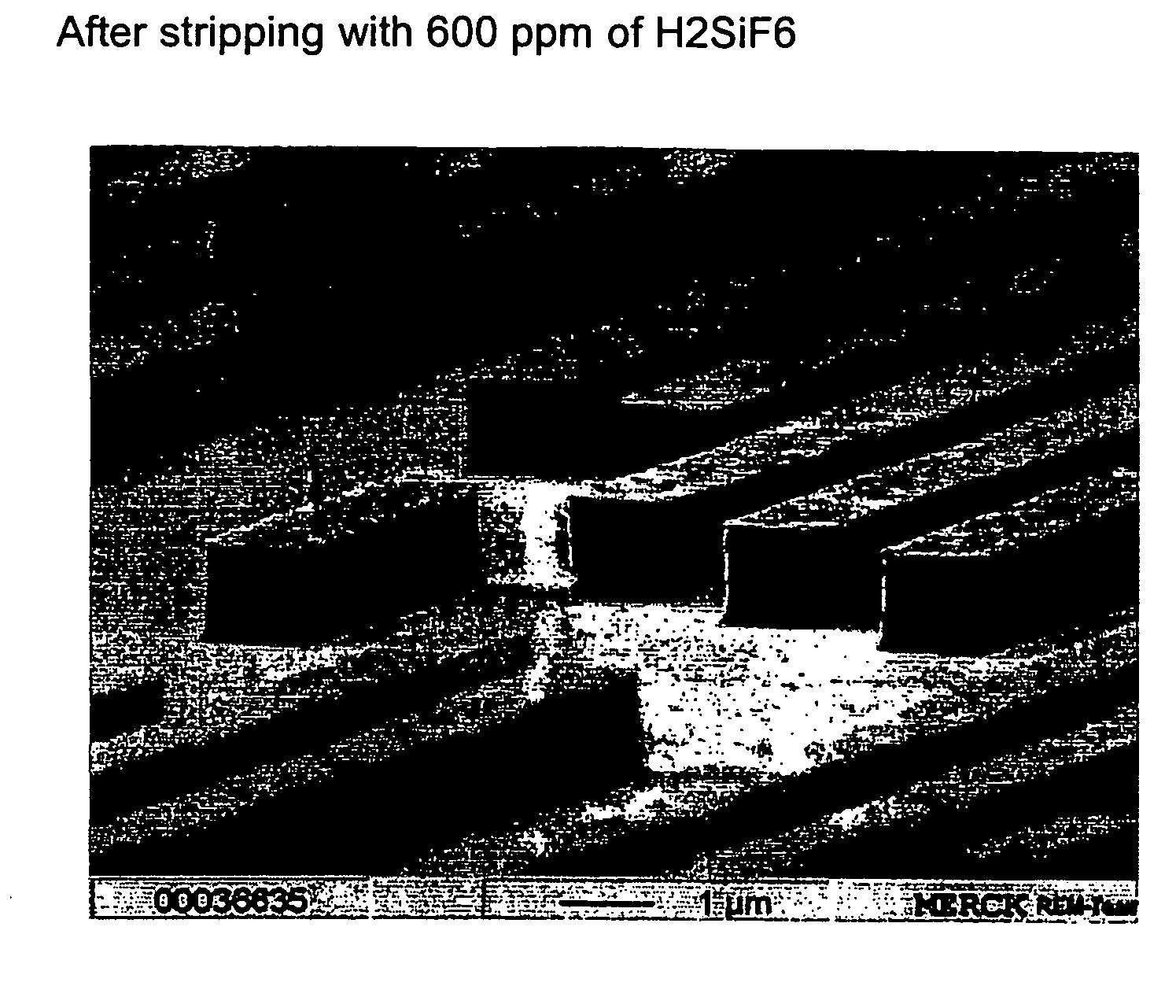Composition for the removing of sidewall residues
- Summary
- Abstract
- Description
- Claims
- Application Information
AI Technical Summary
Benefits of technology
Problems solved by technology
Method used
Image
Examples
example 1
[0045] Etched wafers having the layer structure described above were processed in the SEZ spin etcher. This technology is a single-wafer process in which the wafer lying horizontally in a process chamber is set in rotation and impinged on by the etching liquid via a nozzle. In the process, the nozzle arm moves horizontally to and fro over the wafer surface. The etching process is followed by a rinsing process with ultrapure water in accordance with the same principle. For drying, the wafer is finally blown dry with N2 at a high rotational speed.
[0046] Step 1: Stripping
[0047] Composition of the mixture:
Sulfuric acid:12.0% by weightHydrogen peroxide: 2.4% by weightH2SiF6:500 mg / kg
[0048] 600 rpm, 1 l / min through-flow, 25° C., 30 sec.
[0049] Step 2: Rinsing with Ultrapure Water
[0050] 600 rpm, 1 l / min through-flow, 25° C., 30 sec.
[0051] Step 3: Spin Drying with Blowing off by N2
[0052] 2000 rpm, 150 l / min.
[0053]FIG. 3 shows the fully cleaned surface, without attack of the metallis...
example 2
[0054] The same wafers as in Example 1 were processed in a Mattson AWP200 tank unit.
[0055] Step 1: Stripping
[0056] Composition of the mixture:
Sulfuric acid:12.0% by weightHydrogen peroxide: 2.4% by weightH2SiF6:100 mg / kg
[0057] 15 l / min. recirculation, 25 ° C., 45 s
[0058] Step 2: Rinsing with Ultrapure Water
[0059] 35 l / min through-flow, 25° C., 10 min.
[0060] Step 3: Marangoni Dryer
[0061]FIG. 3 shows the fully cleaned surface, without attack on the metallisation.
example 3
[0062] The same wafers as in Example 1 were processed in a beaker. For better characterisation of the stripping process, wafers with very thick polymer layers were used.
[0063] Step 1: Stripping
[0064] Composition of the mixture:
Sulfuric acid: 12% by weightHydrogen peroxide:2.4% by weightH2SiF6:100 mg / kgOenanthic acid: 80 mg / kg
[0065] 100 rpm. 25° C., 60 sec.
[0066] Step 2: Rinsing with Ultrapure Water in the Beaker
[0067] 25° C., 5 min.
[0068] Step 3: Drying in the Nitrogen Oven
[0069] 100° C., 10 min
[0070] It can be seen in FIG. 12 that the polymers have been removed apart from a thin residual layer.
PUM
| Property | Measurement | Unit |
|---|---|---|
| Temperature | aaaaa | aaaaa |
| Fraction | aaaaa | aaaaa |
| Fraction | aaaaa | aaaaa |
Abstract
Description
Claims
Application Information
 Login to View More
Login to View More - R&D
- Intellectual Property
- Life Sciences
- Materials
- Tech Scout
- Unparalleled Data Quality
- Higher Quality Content
- 60% Fewer Hallucinations
Browse by: Latest US Patents, China's latest patents, Technical Efficacy Thesaurus, Application Domain, Technology Topic, Popular Technical Reports.
© 2025 PatSnap. All rights reserved.Legal|Privacy policy|Modern Slavery Act Transparency Statement|Sitemap|About US| Contact US: help@patsnap.com



